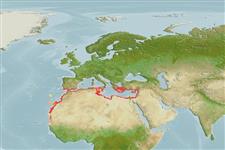Elasmobranchii (sharks and rays) >
Myliobatiformes (Stingrays) >
Rhinopteridae (Cownose rays)
Etymology: Rhinoptera: Greek, rhinos = nose + Greek,pteron = fin, wing (Ref. 45335).
Issue
Considered valid in McEachran and Seret 1990 (Ref. 4441) but with a note that more recent authors consider it to be immature stages of R. marginata. Further study is needed to clarify problem (Ref. 4441). Tentatively valid in Last et al., 2016, for these differ subltly in their morphology (Ref. 114953:719).
Environment: milieu / climate zone / depth range / distribution range
Ecology
Marine; benthopelagic. Subtropical; 38°N - 15°N, 18°W - 36°E
Eastern Atlantic: southern Spain to Senegal, including the Mediterranean.
Size / Weight / Age
Maturity: Lm ? range ? - ? cm
Max length : 200 cm WD male/unsexed; (Ref. 6678)
Found in tropical to warm temperate coastal waters, but absent from islands of western Pacific. Often forming large groups swimming near the surface and quite destructive of commercial oyster and clam beds. Feeds on bottom-living mollusks, crustaceans and fishes. Seldom marketed. Ovoviviparous, gestation period up to one year with 2-6 embryos produced.
Life cycle and mating behavior
Maturities | Reproduction | Spawnings | Egg(s) | Fecundities | Larvae
Exhibit ovoviparity (aplacental viviparity), with embryos feeding initially on yolk, then receiving additional nourishment from the mother by indirect absorption of uterine fluid enriched with mucus, fat or protein through specialised structures (Ref. 50449).
McEachran, J.D. and B. Séret, 1990. Rhinopteridae. p. 71-72. In J.C. Quero, J.C. Hureau, C. Karrer, A. Post and L. Saldanha (eds.) Check-list of the fishes of the eastern tropical Atlantic (CLOFETA). JNICT, Lisbon; SEI, Paris; and UNESCO, Paris. Vol. 1. (Ref. 4441)
IUCN Red List Status (Ref. 130435)
Threat to humans
Harmless
Human uses
Fisheries: commercial
Tools
Special reports
Download XML
Internet sources
Estimates based on models
Preferred temperature (Ref.
123201): 17.1 - 21.7, mean 19.7 °C (based on 136 cells).
Phylogenetic diversity index (Ref.
82804): PD
50 = 0.5039 [Uniqueness, from 0.5 = low to 2.0 = high].
Bayesian length-weight: a=0.01148 (0.00463 - 0.02844), b=2.98 (2.76 - 3.20), in cm total length, based on LWR estimates for this (Sub)family-body shape (Ref.
93245).
Trophic level (Ref.
69278): 3.8 ±0.60 se; based on food items.
Resilience (Ref.
120179): Very Low, minimum population doubling time more than 14 years (Fec=2).
Fishing Vulnerability (Ref.
59153): Very high vulnerability (85 of 100).
Nutrients (Ref.
124155): Calcium = 11 [2, 53] mg/100g; Iron = 0.54 [0.13, 1.54] mg/100g; Protein = 21.5 [16.4, 26.6] %; Omega3 = 0.193 [0.054, 0.609] g/100g; Selenium = 23.5 [7.3, 75.5] μg/100g; VitaminA = 8.83 [2.81, 27.94] μg/100g; Zinc = 0.539 [0.260, 0.995] mg/100g (wet weight);
